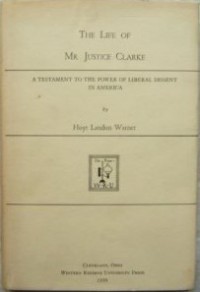A laudatory biography of an obscure justice

John Hessin Clarke ranks among the large body of obscure Supreme Court justices in America’s history, which is unfortunate when considering his particulars of his life. Born and raised in Ohio, Clarke balanced a career in the law with part-ownership in a small-town newspaper and participation in Democratic party politics. An enthusiastic Progressive, he twice sought election to the United States Senate before being appointed to the federal bench by Woodrow Wilson. In 1916 he was named to the Supreme Court, where he served for six years before a combination of personal loss and frustration with his work led him to retire. In retirement, he spearheaded a campaign to convince America to join the League of Nations, one that failed in its stated goals but helped paved the way for America’s participation in the United Nations after World War II.
Given all of this, it is unfortunate that Clarke has attracted so little attention from scholars; indeed Hoyt Landon Warner’s book is the only complete biography about him. In some respects, this is a testament to the author’s thorough work. He draws from numerous archival collections to piece together Clarke’s life, using Clarke’s personal letters and journalism as well as interviews with people who knew the justice to present a comprehensive portrait of his views and jurisprudence. The result is a well-rounded portrait of Clarke, one in which his time on the Supreme Court is just one part of a long and varied life. Yet the broader historical scholarship Warner draws from is notably dated, relying on a presentation of the era that is in need of updating.
More serious is the author’s bias towards Clarke. Warner proves to be a sympathetic biographer – indeed, perhaps too sympathetic of one. His interpretations of Clarke’s actions are invariably favorable or forgiving, with little critical assessment of the justice’s actions and decisions. This is particularly apparent in his chapter on Clarke’s time as a railroad lawyer, in which Warner labors to demonstrate the compatibility of his subject’s legal advocacy with his Progressive beliefs. Such efforts are sometimes so tortuous as to invite incredulity, and can engender doubt about Warner’s overall judgements regarding his subject.
These flaws detract from what is otherwise an informative and valuable work. More than a half-century after its publication, Warner’s book remains an indispensable source for understanding Clarke’s life and career. It succeeds in demonstrating that Clarke was more than a jurist, and in fact had a career marked by success in numerous areas. Hopefully some other scholar will write soon a more up-to-date and balanced assessment of the justice; until then, this is the book to read for anyone seeking to learn about this remarkable figure.






